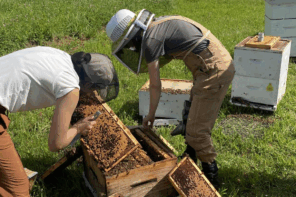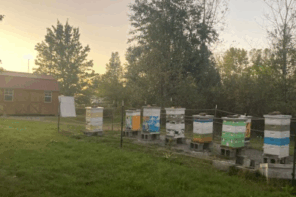By: A.I. Root
This article appeared in the Autumn 2019 issue of BEEKeeping Your First Three Years
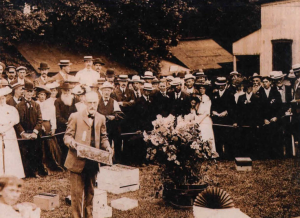 So much of my experimenting, or perhaps to call things by their right name, tinkering with bees in cold weather resulted in nothing but loss that perhaps I might be excused for strongly insisting that the colonies be carefully attended to when it is warm and then let alone during cold spells. Strong colonies take care of themselves in almost all emergencies. I tried hot-beds, glass houses, stoves and a host of appliances to enable me to nurse up weak colonies in the Spring-colonies that should have been united in the Fall, five into one instead of being scattered in five hives. I wondered if we would ever recover from that folly of follies of calling a quart of bees a colony of bees fit to Winter. I am conscious that it hung about my own apiary until I began to feel it the disease of all diseases that was difficult to eradicate.
So much of my experimenting, or perhaps to call things by their right name, tinkering with bees in cold weather resulted in nothing but loss that perhaps I might be excused for strongly insisting that the colonies be carefully attended to when it is warm and then let alone during cold spells. Strong colonies take care of themselves in almost all emergencies. I tried hot-beds, glass houses, stoves and a host of appliances to enable me to nurse up weak colonies in the Spring-colonies that should have been united in the Fall, five into one instead of being scattered in five hives. I wondered if we would ever recover from that folly of follies of calling a quart of bees a colony of bees fit to Winter. I am conscious that it hung about my own apiary until I began to feel it the disease of all diseases that was difficult to eradicate.
How Much Cold Will Bees Stand?
During cold weather, when the temperature does not go lower than somewhere between 30° and 40°, single bees will live from 24 to 48 hours in a dormant state, to all appearance dead. If they are not warmed up and fed at the expiration of this time, or if they should remain out in freezing weather they then pass all human power of resuscitation. When bees are massed together in a cluster they keep up an animal heat that keeps the whole cluster above freezing. This is apparently kept up some hours even after the bees have exhausted all their food and when they are, to all appearances, dead. They will even stand a temperature of zero in this condition, and many of them revive; but if they are left too long, say three or four days, they can not be revived. I made many experiments to test this matter and reported them in the January number of Gleanings for 1876.
Controlled Mating of Queens
Although greatly interested in the progress of the experiments in artificial fertilization of queens, I could see that the experimenters were making little or no progress. I enjoyed my 4th of July in 1871 by making a cheese-cloth box seven feet high and six feet in diameter. I put in a lot of drones and two queens seven or eight days old. As the queens circled around and the drones circled after them I had strong hopes and kept them there for several days, but alas, they circled in vain.
A friend made a house of cloth twelve feet long but with no better success. We both feared going to the expense of wire-cloth but determined to do so should further success be reported. Why couldn’t we have succeeded just once to get a little faith? It is true, as we have many times said, that so far as the production of honey is concerned, the accepted way of letting the queens meet the drones in the air was good enough, provided we had an undoubtedly pure queen to rear cells from. But as every beekeeper wants at least one queen of absolute purity, who was to supply them?
Early Experiments with Baby Nuclei
In 1873 I saw some hives of Italian bees containing but one frame each and that frame was only 2¼ by 3 inches in dimensions; yet notwithstanding this small size, each had a queen and the bees gathered pollen with as much bustle and importance as some greater colony. As one of these queens would fill their comb with eggs in fifteen or twenty minutes, the combs could be watched closely to find when the queens became fertile. My friend who showed me these hives said they were some of his father’s experiments. I felt that if these wee hives could only be managed so that the bees would not swarm out, they would be fine for rearing queens.
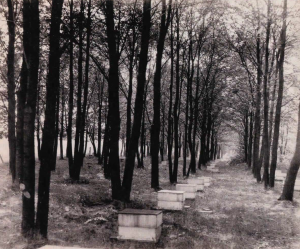 Moving Bees Short Distances
Moving Bees Short Distances
Bees are reported to go back to their original location even after having been removed as far as two miles. I know of no way of moving a colony of working bees during the working season a hundred yards without loss. I made careful experiments in the matter. I smoked, drummed and clustered them with their queen apart from their combs, yet go home they would, a great part of them, in spite of all I could do. To be sure, thoughtless people claim there is no loss, but if they put a similar hive on the original spot they can easily determine how many are lost. If no such hive is used the bees scatter about in a way that is likely to be unnoticed. Careful inspection of the shrubbery at nigh or early in the morning generally reveals the homeless wanderers. Moving the hive a foot a day is the safest plan I know, but it is a great bother and after all a considerable damage to the work of the bees.
Of course, by confining the bees to the hive or by waiting a week or more until after a spell of bad weather, I could move them without much loss; but careful observation showed that even then the older bees, many of them, were missing. I once purchased a colony of bees from a neighbor in January. There was no weather when they could fly until March, but even then so many bees went back that the rest froze outright the first cold night. An examination showed a great part of them scattered about on the ground around their former location.
Why Bees Shake Their Bodies
In regard to why the bees run rapidly over the combs, frequently turning around and shaking their bodies violently, it is my opinion that this is only an expression of rejoicing caused by a sudden yield of honey, an accession to their stores by robbing, by feeding, by fine weather after a storm, by a lot of young bees just emerged, etc. I have seen a whole colony wildly rejoicing just because I gave a few clean empty combs when they had the rest all full. I had no faith that the wax producers have anything to do with it, although I had seen such statements. When a young bee makes its first foraging trip and returns with a load of pollen it seems anxious that all shall notice its great achievement, goes in the hive and out several times, shakes it body, runs against it fellows as though they were of no account, and often seems to induce it fellow juveniles to go forth in hot haste to see if they can not do as well. Bees are as jolly, playful and happy as kittens when once they are known.
Experiments in Swarming
Natural swarming for the first time rather got the better of me in 1870. Removing all queen-cells and all honey, and giving empty combs in the center of the hive, did no good. One colony even swarmed while I had the hive open removing the honey. I thought I would try natural swarming a little, since it had been claimed that such swarms work so much better. However, after some experience of this kind I resolved that if I didn’t take the matter in hand and have swarming when I wished it and how I wished it, it would be because I couldn’t.
Here is my complaint: My first natural (born fool, I should like to say) swarm, I put in a “diamond” hive. It stayed half a day without working a speck and then came out again. As I had no combs of brood the size of that hive I thought I would try hiving them again. But, as soon as the queen was uncaged they were off again. Of course I always kept my queen’s wings clipped, but this time the swarm went off and joined itself with a small swarm of black bees belonging to a neighbor. I hived all the bees, but when explaining the matter to my neighbor he said his bees were yellow, too! So away went half a bushel of my best Italians.
Another swarm acted the same way and I paid $5.00 for a small third swarm of black bees so that I might carry my own Italians home. Still another swarm came out four times and I could keep them only by caging the queen nearly a week.
The Shaken Swarm Plan in 1870
After all this I became disgusted with the state of things and decided to carry out a plan of my own. I shook off all the bees, including the queen, into an empty Langstroth hive on the old stand, and gave the bees one comb of brood, as in case of all the natural swarms. The shaken bees went to work and built more comb in tow days than my natural swarms did in a week. The parent hive had a new location, of course and young bees enough to care for the brood. All were shaded from the hot sun.
In any kind of swarming I always furnished queen-cells or brood from choice stock, selected with a view to give gentle bees and good honey gathers.
The Need of Warm Supers
In the house apiary in 1876 I had, for the benefit of visitors, a full set of fancy glass boxes, with the bees working on the white foundation. To avoid disturbing the bees with too much light when no one was watching them, I threw over the boxes a cloth curtain. On one of the hives I used by accident a thick woolen cloth, and several times when this was carelessly omitted the bees seemed to cease work in the boxes. Further experiments showed this to be the case, for even if the house were as dark as pitch when the spread was left off, the bees would very soon almost desert the outside boxes. This shows that it is very important for comb-honey supers to be well protected from the changes of the weather. This experiment was made during quite warm weather, and the hive was inside the house apiary.
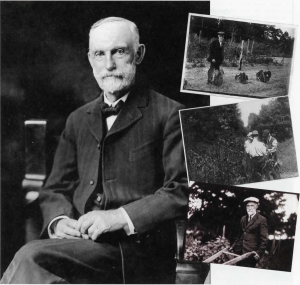 A Self-Hiving Apparatus
A Self-Hiving Apparatus
A beekeeper in Pennsylvania sent me in 1877 an apparatus for hiving a swarm. The plan was to have a colony on a plat form so nicely balanced that, when a swarm left, the hive changed its position enough to close the entrance. The bees were supposed to have been taught previously to go out and in through an empty hive and when they returned as soon as they missed the queen they returned to that empty hive.
I suppose this machine would have worked, and yet even if it did it would not have paid to use it. It would not be practical to make a machine for colony, for they would cost several dollars each and the inconvenience of having hives all encumbered in this way would be out of the question. Why will beekeepers waste their money in patenting things so impractical?







